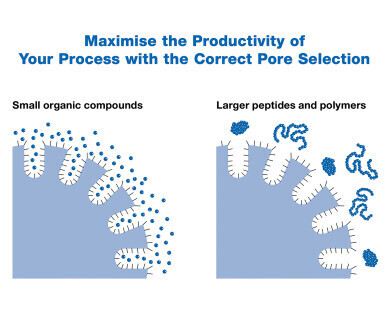Liquid Chromatography
Maximise the Productivity of Your Process with the Correct Pore Selection
Mar 26 2024
The selection of the pore size of the stationary phase is of great importance for efficient separations and therefore for productive purification processes. The pore size determines the overall surface area and also the ligand density. For best separation results, the pore size should be selected according to the size of the target molecule.
Correlation between Pore Size and Surface Area of Stationary Phases
The pore size of a stationary phase correlates directly with the specific surface area: The smaller the pores, the larger the total surface area. Therefore, the ligand loading is also higher for smaller pores because a larger surface area is accessible for modification. Consequently, the carbon loading of RP phases is higher for smaller pores. This affects the loadability and the retention behaviour of the target on the stationary phase. With increasing pore sizes, the specific surface area decreases. Consequently, the overall ligand load (in this case the carbon loading of the C18 phase) decreases with larger pores.
The Relationship between Pore Size and the Size of the Target Molecule
The pore size of the stationary phase has a massive impact on the chromatographic separation because this strongly depends on the size of target molecule that has to access the pore. Small molecules can easily access the pores of this stationary phase whereas larger molecules like large peptides, proteins or polymers are excluded from the pores. For these types of molecules, a larger pore is needed. Too small and too large pore sizes lead to decreased resolution and peak broadening. Generally, the pore size should be selected as the smallest possible but the largest necessary.
Selection of the Pore Size based on the Molecular Weight
For optimal separation, the pore size has to be adjusted to the molecular weight of the target. With the YMC selection tool you can immediately find the most suitable pore size at a glance, depending on the size of the target molecule. As a rule of thumb, the larger the target molecule, the larger the pore size of the stationary phase should be and the less hydrophobic the modification of the stationary phase should be. Of course, these values are only recommendations, and the limits are guidelines. It therefore makes sense to test different pore sizes with increased loadings.
Conclusion
To identify the most suitable stationary phase, screening different pore sizes with increased target loadings is a very successful approach. This Technical Note helps to determine the most suitable pore size based on the size of the target molecules and additionally gives practical examples as well as tips for scale up. The full flexibility with YMC stationary phase is an additional benefit for every screening: the stationary phases for preparative purifications YMC-Triart Prep and YMC*Gel are available in many different pore sizes.
Digital Edition
Chromatography Today - Buyers' Guide 2022
October 2023
In This Edition Modern & Practical Applications - Accelerating ADC Development with Mass Spectrometry - Implementing High-Resolution Ion Mobility into Peptide Mapping Workflows Chromatogr...
View all digital editions
Events
Apr 28 2024 Montreal, Quebec, Canada
May 05 2024 Seville, Spain
May 15 2024 Birmingham, UK
May 19 2024 Brno, Czech Republic
May 21 2024 Lagos, Nigeria













